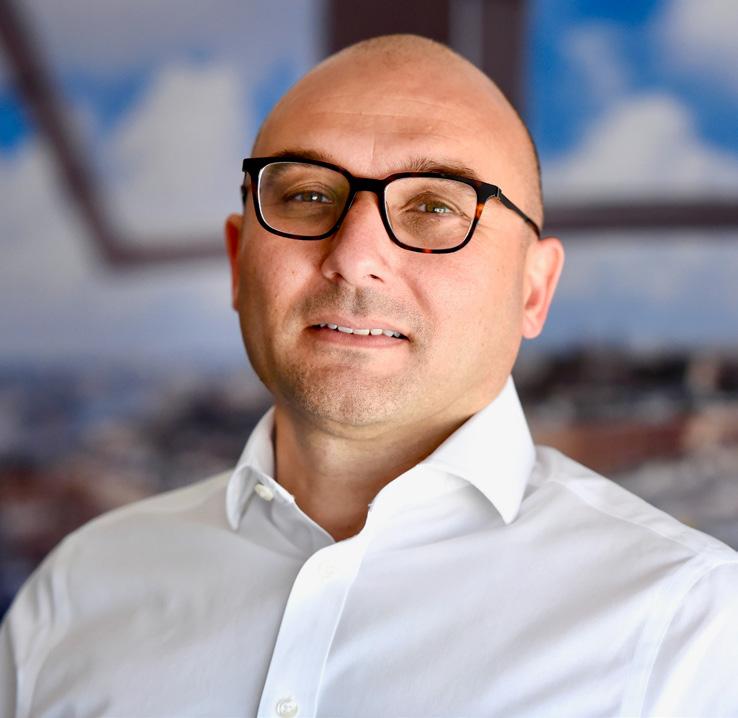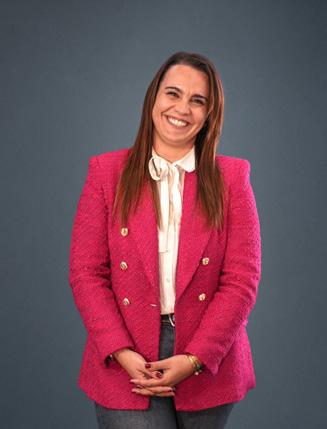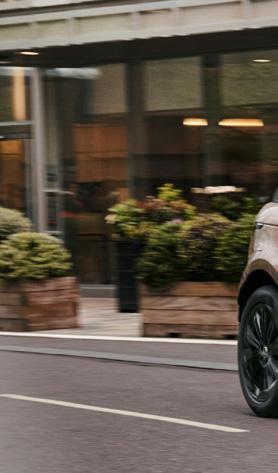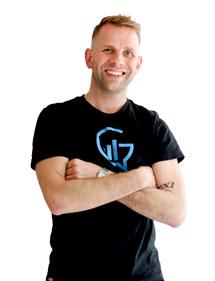FROM HOSTING TO SECURING: THE BMIT EVOLUTION
RISING

ISSUE 77 BUSINESS | LIFESTYLE | DESIGN THE TECH, IDEAS & INNOVATION EDITION AI and Automation’s role in human evolution / 14 AWAKENING THE SPIRIT OF ENLIGHTENMENT Roberta Lepre / 26 CHOOSING YOUR PRIORITIES Ana Rubio / 24
ABOVE GREENFLATION
Jack Mizzi / 20
COVER STORY
Liquidity Management Accounts - giving you the power
Overnight
Our suite of services are geared to support our customers with their banking requirements allowing access to world markets, interest rates and foreign exchange services - a personalised service through one relationship.

Speak
T:
E: PrivateBanking@sparkasse-bank-malta.com
Sparkasse Bank Malta plc, 101 Townsquare, Ix-Xatt ta’ Qui-si-Sana, Sliema SLM3112, Malta.
Sparkasse Bank Malta plc is a public limited liability company registered in Malta with registration number C27152 and registered office at 101 Townsquare, Ix-Xatt ta’ Qui-si-Sana, Sliema SLM3112, Malta. Sparkasse Bank Malta plc is licensed by the Malta Financial Services Authority to carry out the business of banking in terms of the Banking Act (Cap. 371 of the Laws of Malta), and to provide investment services and custody and depositary services in terms of the Investment Services Act (Cap. 370 of the Laws of Malta).
to manage your liquidity.
an advisor today.
to
our
to
you in optimising
deposits for professional customers -
goal is
support
your returns.

Banking | Custody | Investments Banking Investments - a personalised service through one relationship.
SWITCH OFF as soon as they switch on
You’ll be pleased to hear we’ve got over 250 kids’ channels on our flights. Enjoy some rest and relaxation while they explore worlds of wizards, heroes and aliens. With take-home toys and goodies on top, you can recline your seat and leave the entertaining to us. Fly to over 130 destinations including Dubai, Australia and Cyprus and enjoy the journey as much as the destination.

 Editor’s note — As we transition into a new season, we are thrilled to present the latest edition of Money, a captivating exploration of the realms of AI, tech, startups, and more. Just as nature undergoes shifts, so does the world of innovation evolve, and this edition stands as a testament to the transformative power that shapes our modern landscape. We are reminded of the broader changes shaping our world with the change of seasons upon us. In an era defined by the global drive towards sustainability and climate action, a remarkable economic phenomenon has emerged known as “greenflation.” In a thought-provoking feature, Ana Rubio, founder and CEO of Datalitiks Ltd., delves into the intricate dynamics of greenflation and its potential ramifications on product prices on a global scale. Rubio expertly navigates the intersection of cutting-edge technology and the transformative principles of Environmental, Social, and Governance (ESG) factors, revealing how companies can not only navigate cost challenges but also gain a competitive edge by embracing sustainable practices.
Editor’s note — As we transition into a new season, we are thrilled to present the latest edition of Money, a captivating exploration of the realms of AI, tech, startups, and more. Just as nature undergoes shifts, so does the world of innovation evolve, and this edition stands as a testament to the transformative power that shapes our modern landscape. We are reminded of the broader changes shaping our world with the change of seasons upon us. In an era defined by the global drive towards sustainability and climate action, a remarkable economic phenomenon has emerged known as “greenflation.” In a thought-provoking feature, Ana Rubio, founder and CEO of Datalitiks Ltd., delves into the intricate dynamics of greenflation and its potential ramifications on product prices on a global scale. Rubio expertly navigates the intersection of cutting-edge technology and the transformative principles of Environmental, Social, and Governance (ESG) factors, revealing how companies can not only navigate cost challenges but also gain a competitive edge by embracing sustainable practices.
Amidst these currents of change, the rapid advancements in Artificial Intelligence (AI) and automation have ushered humanity into an era of unparalleled innovation. Just as the seasons shift, AI and automation are reshaping industries, redefining human capabilities, and opening unprecedented opportunities for growth and self-discovery. This edition of MONEY takes an in-depth look at the profound implications of AI and automation on our society, setting the stage for a new era of human potential.
Our cover story invites you to journey alongside Vanessa Macdonald as she uncovers the remarkable transformation of Malta’s economy through the eyes of Jack
Mizzi, the chief marketing officer of BMIT Technologies. What started as secure data storage has blossomed into a comprehensive suite of services, exemplifying the power of innovation to drive transformative change in the business landscape.

Amidst the currents of change, creativity also finds new expressions. Moira Scicluna Zahra’s illustrations reflect the influence of people, places, and cultures, showcasing a versatile range of visual storytelling. From whimsical compositions to intricate artworks, Zahra’s creations echo the ever-evolving diversity of our world.
In the dynamic realm of finance, AI-driven asset allocation emerges as a game-changing force, revolutionising investment strategies. We delve into this groundbreaking application, where machine learning seamlessly intersects with financial expertise, providing seasoned investors and newcomers with a potent tool to navigate the complex economic landscape.
As the world embraces innovation, AI has broken free from the confines of large corporations and is now accessible to small businesses. Richard Muscat Azzopardi explores this transformative shift, demonstrating how even those without technical backgrounds can harness the power of AI, democratising its potential impact.
This edition is a tapestry of transformation, weaving together sustainable enterprises, regulatory compliance, and the ethical considerations of generative AI. As we navigate the ever-changing currents of our world, we remain steadfast in our commitment to shed light on the forces that shape our lives, the challenges we confront, and the promising solutions that lie ahead.
As nature’s rhythms continue their timeless dance, let us journey together through these pages, embracing the evolving landscape of innovation and opportunity.
For information regarding promotion and advertising: [bemags.com/money-pitch] · [hello@bemags.com]
PRINTING Print It DESIGN Be.Communications

Money
by Be

ISSUE 77 MONEY 06 WELCOME
is published
All rights reserved. Reproduction in whole or in part is strictly prohibited without written permission. Opinions expressed in Money are not necessarily those of the editor or publisher. All reasonable care is taken to ensure truth and accuracy, but the editor and publishers cannot be held responsible for errors or omissions in articles, advertising, photographs or illustrations. Unsolicited manuscripts are welcome but cannot be returned without a stamped, self-addressed envelope. The editor is not responsible for material submitted for consideration. Communications Ltd, No. 81, Howard Street, Sliema, Malta SLM 1754 FACEBOOK-SQUARE LINKEDIN · [becommunications.com]
MONEY is hand-delivered to Malta’s businesses, including managers and directors of the country’s top bluechip companies, iGaming companies, all 5-star hotels, including their business centres, executive lounges and rooms (where allowed), all foreign embassies and Maltese embassies abroad (the UK, Rome, Brussels and Moscow). All government ministries and entities.
EDITOR Anthony P. Bernard



Your Technology Solutions Partner With GO Business, your team can make a success of every opportunity. Find out more about our solutions at: go.com.mt/business
THE NEW

Sheer Driving Pleasure



Awakening the spirit of enlightenment

Rapid advancements in Artificial Intelligence (AI) and automation technologies have ushered humanity into an unparalleled innovation and transformation era. MONEY delves into the profound implications of AI and automation on human society, exploring how these technologies lay the foundation for a new era of human enlightenment.
Choosing your priorities
Lawyer Roberta Lepre, Sustainable Enterprise Association Malta founder, talks to Vanessa Macdonald about sustainable enterprise and the importance of having a purpose rather than making profits.
Generative
Some experts have urged halting the development of AI systems stronger than ChatGPT-4, while others advocate for responsible research and safety. Theo Dix delves in.
Malta’s rise in retro
Dayna Camilleri Clarke speaks to three industry professionals to gain an insight into Malta’s vintage scene, from pricing items to where we sit compared to European fashion hubs.
The BMIT evolution
Vanessa Macdonald speaks to Jack Mizzi, chief marketing officer of BMIT Technologies. He reveals the impressive evolution of Malta’s economy through the transformative journey of BMIT Limited, from offering secure data storage to becoming a full-suite provider.
Rising above greenflation
In addition, Moira Zahra started the Malta Community of Illustrators in 2020. It was where local artists could show off their work and begin new illustration projects. Dayna Camilleri Clarke finds out more about the new community.

Who’s responsible?
Stephen Mallia, a regulatory compliance expert, sheds light on Malta’s commitment to the EU’s stringent product safety requirements and implementing the General Product Safety Regulation (GPSR).

AI-driven asset allocation
Paul Rostkowski delves into the realm of AI-driven asset allocation, an application that harnesses the formidable capabilities of machine learning to optimise investment portfolios. By seamlessly melding cutting-edge technology with financial strategy, AI-driven asset allocation offers a powerful tool for seasoned investors and those venturing into the market.
CONTENTS
AI
More than meets the eye: Introducing MCOI
16 26 38 46 28 34 30 20 24 COVER STORY
Ana Rubio, founder and CEO of Datalitiks Ltd., delves into the intricate dynamics of greenflation and its potential impact on product prices worldwide.
Beyond the brochure: the irrational factor in real estate investments
Justin Mizzi looks into a multifaceted issue plaguing the tourism sector and our local real estate market – one critical aspect often flies under the radar.
AI is the perfect companion for small businesses
A new era has dawned, with AI becoming more accessible and userfriendly than ever before. Richard Muscat Azzopardi explores how even small business owners can harness the power of AI without needing a technical background or programming knowledge.
11 lessons learned for growing a business
In the fast-paced world of business growth, the path to success is marked by valuable lessons learned along the way.
Josh O’Cock, CEO of Growth Gurus, shares his top 11 insights gained from navigating the dynamic landscape of entrepreneurship.

Autumn apparel
Autumn doesn’t need to be a browner shade of brown. MONEY welcomes the new season with a show of delectable fashion pieces.
Dayna is a senior speech therapist by day and feature writer by night. When she’s not busy fixing words, she is travelling the world and adding to her fridge magnet collection.
ART P.30 NEW OLD P.34
Richard is the CEO of Switch — Digital & Brand, a marketing agency that forms part of ICOM, the world’s largest network of independent agencies.
AI P.52
Theo Dix is a senior manager leading EY- Parthenon, the global strategy consulting arm of EY in Malta.


AI P.28
Vanessa had every intention of retiring but so far has been caught up by exciting freelance projects and voluntary work.
COVER STORY P.20 SUSTAINABILITY P.26

CONTENTS
48 52 56 64









The Point, Tigne Opening Soon at Mercury Towers

ISSUE 77 MONEY 16 AI
AWAKENING THE SPIRIT OF ENLIGHTENMENT
Exploring AI and Automation’s Role in Human Evolution
Rapid advancements in Artificial Intelligence (AI) and automation technologies have ushered humanity into an unparalleled innovation and transformation era. This paradigm shift is not only altering the way we work and interact but also has the potential to lead us towards a new phase of human enlightenment. As AI and automation evolve, they are poised to reshape industries, augment human capabilities, and catalyse unprecedented opportunities for growth and selfdiscovery. MONEY delves into the profound implications of AI and automation on human society, exploring how these technologies lay the foundation for a new era of human enlightenment.
AI, often described as the simulation of human intelligence processes by machines, has undergone remarkable progress in recent years. Machine learning, deep learning, and neural network advancements drive this evolution, enabling AI systems to learn, reason, and make decisions akin to human thought processes. Simultaneously, automation technologies have flourished, with robotics, process automation, and autonomous systems becoming integral parts of various industries. Together, AI and automation are revolutionising how tasks are accomplished, and the impact extends beyond efficiency and productivity.
One of the cornerstones of the potential that AI and automation hold is the augmentation of human capabilities. Rather than replacing humans, these technologies empower individuals to achieve more by leveraging AI-driven insights and automating routine tasks. This symbiotic relationship between humans and machines promises to liberate human potential, allowing individuals to focus on higher-order thinking, creativity, and problem-solving. For instance, AI-powered
medical diagnostics assist doctors in making accurate decisions, while automation streamlines administrative processes, enabling healthcare professionals to concentrate on patient care.
Automating routine tasks, from manufacturing to administrative duties, can ensure that our necessities are met without the burden of manual labour. This liberation from labour-intensive jobs allows us to shift our focus from mere survival to a higher state of selfdevelopment. With AI-driven systems streamlining industries and augmenting productivity, individuals are poised to channel their energies into pursuits that enrich their minds and souls. This marks a departure from the traditional paradigm of toil-for-subsistence and ushers in an era where the pursuit of knowledge, creativity, and personal growth takes centre stage. As AI and automation assume the roles of caretakers for our foundational needs, we can ascend the ladder of enlightenment, dedicating ourselves to pursuits that ignite our passions, broaden our perspectives, and elevate our understanding of the world and our place within it. »
MONEY THE TECH, IDEAS & INNOVATION EDITION 17 AI
AI and automation’s role in fostering human enlightenment extends to creativity and innovation. Machine learning algorithms can analyse vast datasets, identifying patterns and trends humans might overlook. This capability can inspire artists, designers, and scientists to unearth novel insights, pushing the boundaries of their respective fields. For example, AI-driven algorithms assist musicians in generating innovative compositions, and architects design structurally efficient yet aesthetically captivating buildings. By offloading data-driven tasks to AI, humans are liberated to engage in exploratory endeavours that could redefine the limits of human ingenuity.
Another area where AI and automation have a significant impact is education. Personalised learning platforms powered by AI adapt to individual students’ learning styles, pacing, and preferences. This tailored approach fosters deeper engagement and comprehension, revolutionising traditional educational paradigms. Furthermore, AIdriven tools facilitate curating vast educational resources, making

knowledge accessible globally. On the other hand, automation can help automate administrative tasks in education, enabling educators to focus on mentorship and fostering critical thinking among students. This transformation in education aligns with the tenets of enlightenment, which emphasise the dissemination of knowledge and the development of an informed and empowered populace.
While the prospects of AI and automation leading to a new human enlightenment are promising, they also have challenges that must be addressed. Ethical concerns, such as bias in AI algorithms, privacy infringements, and job displacement due to automation, require thoughtful consideration. It is imperative to ensure these technologies are developed and deployed with transparency, fairness, and inclusivity. Striking a balance between technological advancement and ethical responsibility is crucial to avoiding potential pitfalls and promoting a harmonious integration of AI and automation into society.
For the potential for enlightenment to be realised, cultivating digital literacy and mindfulness becomes paramount. As society increasingly relies on technology, individuals must develop the skills to critically navigate the digital landscape. Understanding AI’s capabilities and limitations, discerning reliable information from misinformation, and adapting to technological changes are crucial
components of digital literacy. Practising mindfulness in technology usage can help individuals harness AI and automation’s benefits without becoming overwhelmed by their omnipresence.
While predicting the exact timeline for the evolution of AI and automation and their impact on human enlightenment is challenging, we can outline a plausible timeline based on current trends and developments:
Short-Term (2023-2025)
In the immediate future, we can expect further integration of AI and automation in various industries, focusing on efficiency and productivity gains. AI-driven personal assistants, smart home systems, and improved virtual reality experiences could become more commonplace, enhancing daily life convenience. Educational institutions will increasingly adopt AI-powered personalised learning platforms, tailoring education to individual needs.
ISSUE 77 MONEY 18 AI
AI marks a departure from the traditional paradigm of toil-for-subsistence and ushers in an era where the pursuit of knowledge, creativity, and personal growth takes centre stage.
Mid-Term (2026-2035)
In the next decade, AI and automation will likely make significant strides in augmenting human capabilities. AI systems could become more adept at tasks requiring nuanced decision-making and creative thinking, such as assisting in medical diagnoses and scientific research. Automation might lead to manufacturing, logistics, and transportation advancements, but concerns about job displacement and retraining may also intensify during this period.
Cultivating digital literacy and mindfulness will become more critical as technology permeates every aspect of life. Ethical considerations surrounding AI bias, data privacy, and algorithm transparency will drive policy discussions and regulations to ensure responsible AI development.
Long-Term (2036–2050 and beyond)
As AI and automation mature, the focus could shift from mere augmentation to the convergence of human and artificial intelligence. We might witness the emergence of sophisticated AI companions capable of deeper emotional understanding and meaningful interaction, potentially reshaping how humans relate to technology. Industries that involve complex decision-making and creativity, such as the law and the arts, could see increased collaboration between humans and AI systems.
The boundaries between education and AI-driven knowledge acquisition might blur, prompting a reimagining of traditional learning models. The concept of a “new human enlightenment” could become more pronounced as individuals have more opportunities for selfdiscovery, creativity, and exploration due to AI and automation’s alleviation of routine tasks.

It’s important to acknowledge that breakthroughs or unexpected challenges could significantly accelerate or decelerate this timeline. Technological leaps, regulatory shifts, and societal responses to AI and automation could all influence the trajectory of their evolution. Additionally, external factors such as economic conditions, geopolitical events, and environmental concerns may interact with these technologies unpredictably.
While the timeline for the evolution of AI and automation towards a new human enlightenment remains speculative, the ongoing advancements in these technologies are undeniable. Society is already witnessing transformative changes, and as these technologies mature, they hold the potential to reshape industries, augment human capabilities, and catalyse personal growth and exploration. Balancing these advancements with ethical considerations, digital literacy, and mindfulness will be crucial to realising the positive potential of AI and automation in paving the path to a new human enlightenment.
MONEY THE TECH, IDEAS & INNOVATION EDITION 19 AI
From hosting to securing...
THE BMIT EVOLUTION
Vanessa Macdonald speaks to Jack Mizzi, chief marketing officer of BMIT Technologies. He reveals the impressive evolution of Malta’s economy through the transformative journey of BMIT Limited, from offering secure data storage to becoming a full-suite provider.
It is hard to grasp just how much Malta’s economy has changed in the past two decades, but a look at the evolution of BMIT Technologies gives an important overview as well as a glimpse into the future.
From a data centre and colocation provider, the company has transformed into a full-suite provider, catering for all the IT requirements of its clients through investments in technologies, products and people, which make it unrecognisable.

“These are exciting times for our company. We are on a journey of transformation that allows us to strengthen our position as a leading IT provider in Malta and build our resilience in an ever-changing technology landscape,” Jack Mizzi, chief marketing officer at BMIT Technologies, said.
The company announcement issued in early August shows just how ambitious it is: BMIT Technologies is planning to take over some of the infrastructural assets of GO, among other things, opening even more doors to a very different future.
“We must look to the future. In this business, you must keep pace with change, new
technologies, new security challenges and market pressures. Our experience, expertise and excellence over the years is what drives our strategy to be the IT partner of choice. We strive to become the company that manages the systems that customers depend on to grow their business while allowing them to focus on what matters most,” Mr. Mizzi said.
When BMIT changed ownership just over ten years ago, the company primarily offered colocation and hosting services via a datacentre aimed at the fledgling gaming and financial services industries – both relied heavily on secure data storage, on-premises and eventually in the cloud.
This business model evolved, with BMIT strengthening its role as a data services provider and offering more IT services –across the entire economic spectrum, from SMEs to large corporates and multinationals – reflecting an ever-changing technology landscape. The increase in demand for Cloud services also highlighted a growing attack surface and the importance of cybersecurity.
All of this was complemented by the company’s listing in 2019 on the Malta Stock
Exchange, making it one of the largest listed tech companies on the island.
The next evolution focused on helping and supporting customers, not just within the data centre or the cloud. BMIT also added various managed services to its portfolio, enabling it to design and deploy IT setups and manage some or all services for customers. It was a natural move for a tech company like BMIT, which was
ISSUE 77 MONEY 20 COVER STORY
boosted in 2018 by completing the acquisition of Kinetix IT Solutions.
Mr. Mizzi has been there throughout the evolution, already having spent some years before 2011 in a senior position at GO.
“In 2011, we embarked on a journey which saw us starting to offer cloud services in 2012 – we were the first to provide them in Malta – and
kept adding more and more solutions, both on the data centre side and the cloud side. Initially, the focus was on IT infrastructure and productivity services, targeting international and local companies operating out of Malta, including small ones whose operations were based on knowledge and data.

“We are now at the stage where we are a full suite provider using our own cloud platform,
complemented by global services such as Microsoft Azure and Amazon Web Services. Companies needed to have links between their operational infrastructure, primarily on-premises, and the cloud, which we call hybrid IT, bringing the best of both worlds to our clients.
“We also took the commercial decision to remain vendor agnostic as far as possible, »
MONEY THE TECH, IDEAS & INNOVATION EDITION 21 COVER STORY
giving our clients services linked to their technology of choice so that the focus remains on our customers.”
In the meantime, more and more international customers require super reliable, low-latency and high-speed data connectivity. BMIT teamed up with telecom companies in Malta and overseas to develop its global private network, with a presence in data centres in Frankfurt, Germany and Milan, Italy, connected to its data centres in Qormi and SmartCity, Kalkara.
“In addition to providing unrivalled capacity and performance, we installed protection from Denial of Service (DDoS) attacks, using various technologies and internal expert technical skills, which ensured that if there were an attack on one of our customers, it would be identified and blocked well before it got close to their infrastructure, or other customers,” he explained.
The most crucial thrust is to focus its customers’ attention on cybersecurity issues, which he stressed was anything but
hype, especially given the increase in remote working and multiple access channels, which created many opportunities for cybercriminals.
“This is something that we started to do many years back. We are now making a conscious effort in terms of investment, training and portfolio expansion to offer a new range of services that build on what we already do and enhance it.
“Cybersecurity spans the full range from ensuring that devices used by employees, sometimes the weakest point in the whole infrastructure, are secure to protecting an entire infrastructure. There is no escape: the risks are higher than ever, and the more you rely on IT, the higher the risks,” Mr Mizzi said. “Of course, we were able to do this because we have years of experience securing our own systems, which hosted our clients’ data. Everything is interlinked, and this makes cybersecurity an important pillar.”
So much for the past. What about the future?
BMIT’s chief executive officer made it clear in his review of the group’s 2022 annual report that the group was looking at its next evolution. Clearly, the pace of change will not relent.
“We work in an environment where change is constant, and technology is obviously the driver. If you do not keep up to date, you become irrelevant, and we clearly do not want that! We owe this to our shareholders, employees and customers,” Mr Mizzi said.

ISSUE 77 MONEY 22 COVER STORY
Our customers know they are getting the best possible partner to manage the systems that help them grow their business...
The Volvo XC60

GasanZammit Motors Ltd., Triq il-Merghat, Zone 1, Central Business District, Birkirkara CBD 1020 Tel: 27788225 email: volvo@gasanzammit.com | www.volvocars.com.mt
RISING ABOVE GREENFLATION
Using ESG and Technological Innovation
In the wake of the global drive towards sustainability and climate action, a compelling economic phenomenon has emerged known as “greenflation.” Ana Rubio, founder and CEO of Datalitiks Ltd., delves into the intricate dynamics of greenflation and its potential impact on product prices worldwide. She explores how companies can leverage cutting-edge technology and the transformative principles of Environmental, Social, and Governance (ESG) factors to mitigate cost increases and gain a competitive edge in the market.
The global trend towards environmentally friendly practices and climate mitigation has created a new economic phenomenon called “greenflation.” The idea refers to the potential increase in product prices brought on by more significant financial commitments to initiatives promoting environmental sustainability and adopting climate-friendly corporate practices. This truth has grown more apparent as various countries, especially those in Europe, work to reduce their reliance on fossil fuels and increase their portfolio of renewable energy sources. However, despite the potential adverse effects of greenflation on
the economy, businesses are discovering a previously untapped opportunity to use cutting-edge technology and ESG factors to reduce these cost increases and gain a competitive advantage.
The Greenflation era is coming
Greenflation results from the higher costs incurred during the shift to a low-carbon economy. These costs may result from various factors, such as rising commodity prices, ESG initiative compliance costs, weather changes brought on by climate change, and changes to manufacturing and supply chains.
According to research by Deutsche Bank, the energy required by 2030 to achieve net-zero emissions by 2050 might be equivalent to a threefold increase in the balance sheets of the US and European central banks since the start of the COVID-19 pandemic. This estimate shows the significant financial inflow that could flow into the sustainability sector, thereby raising prices.
How ESG management plays a part
However, a defence against greenflation could be offered by thoroughly comprehending and successfully integrating ESG factors into organisations’ operations.
Environmental, social, and governance (ESG) risks and opportunities are included in organisational decision-making through ESG integration. For instance, a business that makes significant expenditures on renewable energy may experience higher initial costs, but these could
ISSUE 77 MONEY 24 GREENFLATION
Required energy spending blows covid-stimulus out of the
compared with
$tn
Increase in Fed and ECB assets since Feb 2020 $tn 30 20 10 0 Increase
water — Net zero spending
Fed and ECB balance sheet expansion since covid
Source: Federal Reserve, IEA1, Factset
in clean energy investment needed by 2030 to hit net zero targets by 2050
$tn
ultimately result in sizable savings. In a study published by the Harvard Business School, 180 organisations were examined over 18 years. They discovered that ESG-focused businesses outperformed non-ESG competitors regarding financial health and business performance.
Additionally, ESG integration can benefit businesses by boosting their brand, luring environmentally aware customers, and securing investors. A 2020 survey by the investment company Schroders found that 70% of American investors have grown their ESG fund holdings since the pandemic’s inception. As a result, companies that effectively manage their ESG performance might prosper even during greenflation.
The influence of data and technology
Technology and data analytics play a role in this situation. Businesses can assess their ESG impacts more precisely and prepare for cost rises using appropriate technology.
Tools for data analysis, for instance, can assist companies in monitoring their water use, trash output, and carbon emissions. Businesses can
find opportunities to cut expenses and reduce their environmental impact by spotting trends and patterns in this data. Microsoft and PwC UK studied AI’s contribution to achieving global climate goals. The study discovered that applying AI to environmental applications in four crucial industries—agriculture, water, energy, and transport—could boost the world economy by up to $5.2 trillion and cut greenhouse gas emissions by 4% by 2030.
Technology can help automate compliance with ESG standards, monitor environmental effects, lower administrative costs, and minimise risks. According to a recent Accenture study, businesses that use AI for compliance can cut costs by as much as 50%.

A case study of greenflation-induced success
Take the example of Unilever, a global consumer goods manufacturer headquartered in the Netherlands and the United Kingdom. By 2039, Unilever wants all of its goods to have net-zero emissions. This is an ambitious aim.
Unilever is significantly investing in sustainable practices to achieve this goal. For instance, the company is changing the formulation of its products to lessen their impact on the environment, switching to renewable energy sources for its factories, and taking steps to improve the sustainability of its supply chains. Although these activities may increase costs in the short run, they are expected to result in significant cost savings and brand value over the long term.
Due to its practical ESG management approach, Unilever is a desirable option for ethical investors. According to Morningstar Direct, ESGfocused funds were responsible for the 40% growth in funds invested in Unilever’s shares between 2019 and 2021. Additionally, the company’s dedication to sustainability has reduced its cost of capital. Research from the University of Oxford and Arabesque Partners shows that businesses with strong sustainability practises have capital costs that are 10 to 20 basis points lower.
Unilever has been able to counteract some of the consequences of greenflation and establish itself as a pioneer in sustainability by successfully integrating ESG into its business strategy and using technology to track its sustainability performance.
Greenflation need not be a danger to corporate profitability, despite appearing to be one in the global sustainability narrative. Companies may use greenflation to their advantage and keep a competitive edge by strategically implementing ESG management and technology.
Businesses that accurately monitor their ESG impacts and use technology for data-informed decision-making will surely stay ahead of the competition in this new era of sustainable growth.
MONEY THE TECH, IDEAS & INNOVATION EDITION 25
GREENFLATION
Technology can help automate compliance with ESG standards, monitor environmental effects, lower administrative costs, and minimise risks.
CHOOSING your PRIORITIES
Lawyer Roberta Lepre, Sustainable Enterprise Association Malta founder, talks to Vanessa Macdonald about sustainable enterprise and the importance of having a purpose rather than making profits.


The best way to explain sustainable enterprise is by giving an example. Walk into Veg Box at the entrance to Majjistral Park, and you can find “naturally grown, pesticide-free, organic, locally grown produce.” So far, so good. But it is the purpose that takes it to a whole new dimension: “Stronger communities... supporting those who are at the root of our food system.” “It is imperative that we support those who work the land in a traditional and non-exploitive way.” And that is it, in a nutshell: social enterprise is all about having a purpose rather than making a profit.
The word “sustainable” is essential in this context: the entity needs to be financially sustainable, but the purpose has to be more important than driving profits.
Lawyer Roberta Lepre set up the Sustainable Enterprise Association Malta a few years ago to unite like-minded people. She runs the secretariat with a committee of five, with around 30 members who organise regular networking events open to non-members. One of the committee members, Emanuela, is the founder of Veg Box.
ISSUE 77 MONEY 26 SUSTAINABILITY
Most members are micro-enterprises, but not necessarily non-profit organisations, which takes Roberta back to her ‘sustainability’ point. “There are some 2,000 non-profits in Malta, but many of them are not financially sustainable. But, on the other hand, we fully appreciate that the sustainable enterprise model is not suitable for many companies; it is an alternative that appeals to a few, mostly the younger generation, who are increasingly aware of the flaws in current profit-driven systems.
“Our role is to match their passion for change with sound financial principles, which is where the association and its members can help.” As a lawyer, she is well aware of the need for a proper platform. Before COVID-19, she was involved in an international, EU-funded project on the social innovation ecosystem and ways to fill any gaps. Unfortunately, the resulting research was never published, despite the many concrete recommendations it included.
Although many EU countries have a social enterprise law, Malta did not have one then. This means that there was no clear definition of what constitutes a social enterprise, and without that definition, there was clearly no way to offer anything through encouragement or incentives.
Undeterred, Roberta set up the association, which coincided with the growing emphasis being laid worldwide on the need for environmental, social, and governance principles.
Just before the 2022 election, the law, minus some of the recommendations, was enacted. But it is not yet time to celebrate: in practice, it requires a regulator who has not yet been appointed, which means that it is not yet possible to register as a social enterprise. In the meantime, Roberta and the association are focusing on the different directions that “purpose” could take, taking as their guide the Sustainability Development Index and its 17 goals. Climate change and the fight against pollution need little promotion; they are already clear motivators. However, other issues are lagging, with one important one being the need for research to drive innovation. Another is the need to protect the marine environment, for example.
She is satisfied to note the progress that Malta is making on some indicators, such as gender
equality, and stresses that this will bring benefits to the whole of society.
“We are seeing more equality and certainly more female participation. I hope that this will lead to more women in decision-making roles. It is something that we need to keep an eye on as diversity—for example, on boards—improves outcomes tremendously,” she said.
The fight against poverty is perhaps more nuanced, as Roberta is concerned that the figures used in the index are outdated and may not reflect the impact of current inflation and precarious employment, for example, which will only be captured in the years to come.
Where could sustainable enterprises fit in?
Apart from Veg Box, Roberta has plenty of examples. A restaurant could focus on employing people from disadvantaged backgrounds, for example.
something we can see yet…” she added.
However, there is a glimmer of hope: cooperatives could provide an attractive model as they pay lower taxes, re-investing into the enterprises.
Another positive development over the years is that companies, listed or not, are paying far more attention to corporate social responsibility, including their operations, while the EU’s Green Deal is making sure that investors who want to put their money into environmentally sound enterprises have all the information they need before they make their choices.
Roberta is now focused on ensuring that anyone interested in setting up a social enterprise gets the professional advice they need. With Cyprus, an online course was created with €60,000 in EU funds that is self-paced with several live sessions to help participants.
There are other solutions: SOS Malta also offers a certification course, with another being developed by the Maltese-Italian Chamber of Commerce. In addition, other avenues for mentoring are being pursued.
“We feel that the capitalist model of the past is not succeeding, and there is much more awareness of the impact on working conditions, income inequality, and even falling trust in the institutions. Therefore, we need to develop better solutions,” she said.
“Ireland is very active in this area. We could get ideas from there. We don’t need to reinvent the wheel,” she explained.
She is under no illusions: doing things the right way can cost more.
“Take the issue of a living wage. If you pay your staff more than the minimum, it means that it is harder for you to compete. Much of procurement is based on the cheapest offer, which means it is harder for a social enterprise, whether you are bidding for cleaning or providing caring services. Ideally, procurement would lay down minimum environmental and social impact standards, but that is not
“Business leaders are expected to have more sensitivity when making decisions. Shareholders might expect a return on their investment, but this does not mean that companies cannot articulate some sense of purpose... This is a real opportunity for them to step up. Since cost and competition are issues, regulation could step in to push for better outcomes.
“We need to ask ourselves how much we actually need and what it takes to be happy. This concept has gained ground over the decades, and there are calls from many experts to re-evaluate gross domestic product as the way to measure success. This was the “north star” for many years, but has COVID-19 not taught us anything about what is important?”
MONEY THE TECH, IDEAS & INNOVATION EDITION 27 SUSTAINABILITY
Our role is to match their passion for change with sound financial principles.
Generative AI -—>
THE DAWN OF A NEW ERA
Generative AI creates fresh text, photos, video, audio, code, or synthetic data. Generative AI might transform society. Yet, generative AI may increase deep fakes, create material, and perpetuate prejudices and inequality. Some experts have urged halting the development of AI systems stronger than ChatGPT-4, while others advocate for responsible research and safety. Theo Dix delves in.
As the world rapidly evolves, generative artificial intelligence (AI) is emerging as a driving force for innovation and is ready to transform countless aspects of our lives overnight.

Think of it as a very clever search engine or personal assistant that can give precise output to a question or task you have for it. While a traditional search engine would rely on keywords to provide a list of links to your queries, generative AI could generate new content that directly answers your question with output in any of the forms above. For example, if you asked Google’s search engine how to write a piece of software code for a specific task, it would return a list of links to various web pages. If you asked ChatGPT-4 to do the same thing, it would provide you with the actual software code you are after without you ever needing to learn or even understand coding.
This technology can accelerate innovation at a pace we have never experienced before and for virtually every segment of society. For example, imagine an older person with dementia, a condition that impairs the ability to remember, think, or make decisions to carry out day-to-day activities. If integrated into a friendly and intuitive conversational interface, generative AI could offer tailored assistance and companionship and help alleviate the loneliness and isolation that often accompany dementia. Simultaneously, it would also reduce the burden on caregivers and family members.
In education, generative AI could revolutionise the learning landscape for children by serving as an interactive and adaptive learning companion. The AI could cater to each student’s unique learning style and pace. Students would receive personalised attention and guidance, ensuring that each of them has best-in-class guidance beyond the classroom.
In addition to student benefits, generative AI can significantly impact teachers and their workload. For example, one of the most timeconsuming tasks for educators is marking assignments after school hours. AI systems can streamline this process by automatically assessing students’ work and providing personalised feedback for each student. This would save teachers valuable time and ensure consistent and objective feedback. Teachers could then spend more time planning lessons, designing engaging activities, and refining teaching methods.
Generative AI could open new doors for communication and selfexpression for individuals who cannot read or write. Here, the AI could leverage voice-driven interfaces and natural language processing capabilities to enable these individuals to engage with written content in a way that was not previously possible. From consuming news articles and books to participating in online discussions and creating content, the potential for empowerment is limitless.
While the prospects of generative AI are exciting, it is crucial to
ISSUE 77 MONEY 28
AI
acknowledge the potential risks associated with this technology. For example, a proliferation of deep fakes and fabricated content could lead to widespread disinformation and manipulation. Furthermore, there are significant concerns about the potential for AI systems to perpetuate existing biases and inequalities.
The biggest concern for many is God-like AI systems, which, it is important to note, have not yet been created and may never exist. There is concern that misaligned goals could result in devastating unintended consequences. There are concerns that if such power were to be concentrated among a few individuals, companies, or nations, this could disrupt the societal and economic balance of the world. Hence, we must remain vigilant in addressing this through appropriate governance and oversight to create a responsible and ethical AI landscape.
In March this year, over 1,000 AI experts, including Elon Musk and Apple’s co-founder Steve Wozniak, issued a public call for a six-month pause on creating AI systems more potent than ChatGPT-4, which can engage in human-like conversations and make music and software code. The letter argued that AI systems with humancompetitive intelligence present significant threats to humanity. The letter recommended that during the pause, AI labs and independent specialists should collaborate to create and enforce a collection of standard safety guidelines for advanced AI design and development, which would be thoroughly audited and supervised by external independent experts. In addition, the letter suggests that governments intervene if scientists do not willingly halt their efforts on AI systems surpassing ChatGPT-4, which the authors identify as the threshold for gigantic models.

The AI experts from the opposing side argue that putting a pause on the development of powerful AI models could hinder innovation and progress in the field. Instead, they advocate for implementing responsible research practices and introducing robust safety measures to address potential risks associated with AI technologies.
Moving beyond the concerns associated with the technology, another risk is that some countries may fall behind if they do not invest in the necessary infrastructure to drive innovation. For example, despite the vast potential of generative AI, a significant barrier remains for countries like Malta, which have relatively small populations of native language speakers. Natural Language Processing (NLP) technology, the foundation of generative AI, requires extensive resources and training
data to understand the nuances of strings of text to understand their correct meaning and context. For languages with fewer speakers, like Maltese, these resources are often scarce, which makes it challenging to develop advanced AI applications.
The country must focus on implementing its national AI strategy to ensure that Malta can fully embrace the opportunities offered by generative AI. This strategy, published a few years back at a time when AI was not very mainstream, was ambitious in what it set out to achieve. It outlined several AI pilot projects, some of which are linked to generative AI, alongside dedicated initiatives to develop and train Maltese language tools and models to support the development of textand voice-driven Maltese language AI applications.
Examples of the pilot projects to be developed as part of Malta’s AI strategy include adaptive learning platforms for education, which would help students learn at their own pace and receive the proper assistance at home after school. Another project involves a chatbot system to handle customer service queries for the public sector and a digital tourism platform that would curate tailored tourism experiences for different visitors. Beyond these projects, other use cases include using AI to control traffic lights and applying predictive modelling to vast arrays of data to manage traffic flow best.
The strategy envisions Malta as the “Ultimate AI Launchpad” – a place where local and foreign companies and entrepreneurs can develop, prototype, test, and scale AI, ultimately showcasing the value of their innovations across an entire nation primed for adoption. The ambition is to create the conditions for AI to springboard from Malta to the world, underpinning a vision to transform Malta into a leading economy in the field of AI by 2030. It was published alongside Malta’s Ethical AI Framework, which included principles, governance and control practices to serve as the foundation for designing and implementing ethical and trustworthy AI.
As we look to the future, we must ask ourselves: what opportunities lie ahead for Malta as it strives to harness the power of generative AI and fulfil its ambition of becoming a launchpad for AI innovation?
MONEY THE TECH, IDEAS & INNOVATION EDITION 29
AI
Acknowledging the potential risks associated with this technology is crucial.
MORE THAN MEETS THE EYE
People, places, and cultures are the main influences on Moira Scicluna Zahra’s illustrations. She describes her visual style as “quite versatile, ranging from playful compositions of people, patterns, and shapes to more expressive and textural artworks with visual storytelling elements.”
Zahra’s work can be found in magazines, journals, websites, applications, advertising, animations, products, and awardwinning children’s books. In 2017, she co-wrote her first book for kids. It won the 2018 Malta National Book Prize for Best Original Work (Ages 0–7) and Best Book Production. In addition, Zahra started the Malta Community of Illustrators in 2020. It was where local artists could show off their work and begin new illustration projects. Dayna Camilleri Clarke finds out more about the new community.
ISSUE 77 MONEY 30 ART
∙
∙
INTRODUCING MCOI
When did you set up the illustrators group?
We set it up around March 2020, the beginning of the COVID-19 pandemic. I think all of us were a bit lost and spending too much time at home, and I guess had it not been for that, our community would not exist.
Where did the idea come from?
I had been talking about creating a community for local illustrators with various friends, but what pushed me to make it was a conversation with Maltese illustrator Steven Scicluna, who is also one of the MCOI founders. We wanted a place for Maltese illustrators to talk about projects, share, collaborate, or even ask technical questions in a safe space. As soon as we launched our small Facebook group, we realised how much of a need there was for it. Projects started coming in instantly, and fortunately, they don’t look like they will stop anytime soon!
What are the positives of having such a collaboration?
Having a community is always a bonus. Local illustrators can ask about rates and pricing so we know that we are all on the same page, more or less. We also try to teach Maltese illustrators about contracts and licensing. The benefits are, of course, having local illustrators who are more professional and knowledgeable, not just about the
having some work exhibited in London. We also send our annual event to various local and international agencies and publishing houses.
How many local illustrators are involved in MCOI?
Several experienced illustrators are effectively the ‘board’ of the MCOI. The board is quite large, so there could be

medium but also about its business and ethical sides. More positives include further opportunities for networking and showcasing local illustrations outside of Malta. So far, we have showcased twice in Madrid and are in the process of

around ten members involved, but everyone does so if they have enough time. This helps with transparency and keeps the MCOI going. The rest are, of course, outstanding members of MCOI. Our group has more than 350 members, so despite illustration being quite a niche industry, several people are involved.
How has the group been received so far?
We have worked with national newspapers and the Maltese embassy in Spain and received funding from the Malta Book Council and Arts Council Malta. The MCOI is now an MCAST research project, so it’s safe to say that the group has been very well received, and we have worked on many different projects in Malta and beyond.
What’s next on the horizon for MCOI?
We are planning our next annual, and we are also working on an online directory where clients, galleries, and agencies will be able to find a local illustrator online.
MONEY THE TECH, IDEAS & INNOVATION EDITION 31 ART
Visit maltaillustrators.com for more information.
We wanted a place for Maltese illustrators to talk about projects, share, collaborate, or even ask technical questions in a safe space.
Artwork by Daniel Borg. One of six mural illustrations by varied artists commissioned by the New Arts Council of Malta’s offices
MCOI Annual 2020, photo by Te Fit-Tazza
PAST PROJECTS




ISSUE 77 MONEY 32
Artna
ART
An online exhibition of illustrations about the destruction of Malta's environment.
↑ For Our Trees
Ed Dingli
←
Kastelli tar-Ramel Marietta Mifsud
Arkichetchkur Craig Macdonald ↓
Mighty Mechanical Crane Philip Sultana →
Malta: A Meeting Point


A collaboration with the Embassy of the Republic of Malta in Spain celebrated the anniversary of Malta's independence at the Real Jardín Botánico in Madrid with an event that included the inauguration of an outdoor illustration exhibition.

Kliem ix-Xjuħ

We want to acknowledge their experience, honour their long lives and individual stories, and remind ourselves of the importance of their presence within our communities. The pandemic has invited us to revisit the age-old mantra, "Respect your elders."

MONEY THE TECH, IDEAS & INNOVATION EDITION 33 ART
← Carmen Kathleen Flask
←
Kappella tad-Duluri Derek Fenech
Doris Steffi Venturi ↓
→
Inside Balcony Ramon Fiott

ISSUE 77 MONEY 34 NEW OLD
THE NEW OLD
Malta’s rise in retro
Dayna Camilleri Clarke speaks to three industry professionals to gain an insight into Malta’s vintage scene, from pricing items to where we sit compared to European fashion hubs.
A new wave of shoppers is re-discovering older trends to be unique, save money, and reduce textile waste from fast fashion. The new “maximalism” trend also draws heavily from mix-and-match vintage styles, emphasising clashing patterns and colours, a theme heavily dominating 2023 catwalks.

While vintage shopping is nothing new and certainly big business in many capitals across the globe, the stark difference is that today, we are faced with a more conscious consumer towards vintage products and few dedicated shops within the islands.
MARIA CUTAJAR Fashion designer and lecturer
my choice of wearing second-hand clothes, expressing concerns about their origins. But, to their doubts, the washing machine works wonders, capable of removing all traces of the past!
“My journey into thrifting started fifteen years ago by perusing through my grandmother’s wardrobe. Captivated by its unique and timeless pieces, I soon started frequenting charity shops for thrifting finds. I vividly remember my friends questioning
“When I moved to Florence as a budgetconscious student, thrifting became my go-to method for acquiring affordable clothing. The beauty of Florence was that I could easily find woollen jumpers from the ‘80s and ‘90s for just one euro. Even now, in Malta, I continue to embrace thrifting as one means of finding unique finds; one notable event is my attendance at the Malta Fashion Awards wearing an upcycled thrift dress that I had dyed myself! »

MONEY THE TECH, IDEAS & INNOVATION EDITION 35 NEW OLD
Today we are faced with a more conscious consumer...
— Maria Cutajar
“Though thrifting may not be considered a new trend in Malta, people have become more conscious of sustainable living, leading to an increase in thrifting enthusiasts. I think of vintage as another term for old clothing - an attempt by marketers to create an upscale feel when purchasing from vintage shops rather than thrift stores, the primary difference being that branded items may be found. Although sometimes thrift shops can hold some surprises too!
“Thrifting has long been an international trend. Unfortunately, people in Malta generally think that new is always superior; however, Gen Z has experienced a change in attitude by prioritising sustainability within their lifestyles and choosing thrift store shopping without facing stigma or peer pressure. Now, it has become something celebrated across social media networks worldwide.
“However, compared with London and Italy, vintage shops in Malta tend to be overpriced, limiting the development of a circular and sustainable fashion industry. Individuals may opt for fast fashion retailers instead of sustainable alternatives; therefore, for Malta to truly embrace sustainable fashion, it must align its pricing and accessibility of thrift and vintage items with other global fashion capitals”.
LAURA JANE TAYLOR Owner and founder, TaylorMaid Vintage Store, Sliema

the response to the shop has been. The main feedback I get is “Malta needed this”, which gives me a little insight into the fact that I’m offering something welcomed here. The 90s are having a massive comeback, which brings me lots of nostalgia, but my favourite things to source are the 60s, 70s, and 80s. It’s too hard to decide on just one decade!”. Taylor decided to launch after seeing immense success on both Instagram and a dedicated website.
“There is a resurgence in demand for unique, sustainable, vintage clothing. I’m completely overwhelmed at how wonderful


“I want to break the stigma of it being “second hand”, as vintage is not simply second hand. It’s so much more. Shopping vintage allows you to have that unique piece

ISSUE 77 MONEY 36
NEW OLD
Vintage items were made to last...
— Laura Jane Taylor
that no one else has. Vintage items were made to last, so they are still in excellent condition despite being up to 50 years old. Sadly, this is not something you can get with today’s fast fashion.

“With fast fashion being so affordable, it can be challenging to understand why vintage items are often priced at a similar cost or higher. It’s important to recognise that fast fashion brands can offer cheap clothing because they do not pay their workers fairly or their supply chain a decent living wage, so who is paying the price? Fast fashion tends to last only a short time, too, whether that be due to the items being made poorly or because trends change so frequently. So overall, people spend more money on fast fashion as it needs to be replaced regularly.
The way I like to shop is to buy one beautiful piece that I will wear repeatedly and treasure for years to come rather than buy lots of cheap things that I won’t appreciate or won’t last. So, with the store’s opening, I can show people how fashionable vintage clothing is and help people find those unique pieces they can treasure.
“So this is what I apply when I price the items. I consider things such as the brand and designer, the item’s condition, the age and the rarity. I want to keep this affordable, so I do a lot of research into pricing to ensure that the price I am offering is fair. Luckily, this has become a lot easier through years of research and being a vintage lover. As I mentioned, there’s a vast difference between second-hand and vintage, which is reflected in the price. We hand-source vintage gems from an era gone by from across the globe. We are not a thrift store or a charity shop”.
ADRIANA CALLEJA Fashion stylist


to change this by showing their thrift purchases or making their clothes out of upcycled fabric.
“The fashion world is constantly recycling clothes and inspirations from different eras. Still, when it comes to quality nowadays- you can forget it if it’s part of the fast fashion industry. In the alternative scene, select individuals will portray their uniqueness with vintage pieces (either in their original state or upcycled with their art). Let’s hope this trend kicks in more for authenticity and sustainability sake!”
Adriana Calleja
“Regarding vintage fashion, Malta is slightly behind, even in thrift shopping. Thankfully, a few artists and influencers are trying

MONEY THE TECH, IDEAS & INNOVATION EDITION 37
NEW OLD
When it comes to quality nowadays, you can forget it... —
WHO’S RESPONSIBLE?
Stephen Mallia, a regulatory compliance expert, sheds light on Malta’s commitment to the EU’s stringent product safety requirements and implementing the General Product Safety Regulation (GPSR), which places added responsibility on manufacturers, importers, and distributors.

ISSUE 77 MONEY 38 COMPLIANCE
As a general consensus, the Maltese are more likely to seek the responsibility of good service than ensuring the responsibility of providing a safe product. However, since Malta acceded to the European Union (EU) in 2004, we have been subject to the EU’s strict product safety requirements through a structured web of legislation. This results in regulations and directives that implement requirements by adhering to product-related safety standards. Being part of the EU means that the safety of goods across member states is a shared responsibility, and Malta is no exception. Whether we’re talking about toys, construction products, electrical appliances, or machinery, every item available on the market is subject to the EU’s strict safety regulations. The onus of upholding these minimum safety standards falls not only on manufacturers but also on importers, distributors, and national regulatory bodies.
With the implementation of the General Product Safety Regulation (GPSR), Regulation (EU) 2023/988, which officially came into effect on the 12th of June 2023 and will supersede the existing directive on the 13th of December 2024, the spotlight on manufacturers has become more pronounced than ever. Of course, marketing safe products is not a new mandate for manufacturers. However, the recent regulation amplifies this commitment, extending additional customer-centric protections.

Manufacturers now shoulder a heightened responsibility, necessitating not just the design and production of goods in line with EU safety regulations but also conducting thorough risk assessments and
adopting measures to mitigate potential hazards. If a product is found unsafe once it has been shelved for customers to purchase, manufacturers must quickly take corrective action, which could include product recalls.
In the product safety equation, manufacturers and distributors play more roles than simply producing and selling. They also bear the significant responsibility of enlightening consumers about the safe use of their products. This often transpires through channels like informative advertising, comprehensive user manuals, or direct safety warnings, all geared towards fostering a safe user experience. They must also implement an effective system for recording and addressing consumer complaints and product safety incidents. Suppose these are delivered as prepared by their suppliers abroad. In that case, it is within their duty to ensure that the information conveyed meets the specifications imposed by various directives and regulations that concern the specific product or service. This critical aspect of customer service enhances consumer trust and provides valuable insights that can lead to product improvements.
The spotlight on compliance becomes exceptionally bright when manufacturers are located outside the European Union. In these scenarios, the mantle of responsibility is passed on to the importers, who find themselves on the frontlines of product safety regulation.
It’s up to these importers to ascertain that the products they usher into the EU market are in strict accordance with all relevant »
MONEY THE TECH, IDEAS & INNOVATION EDITION 39
COMPLIANCE
safety requirements. If necessary, they are expected to verify the manufacturer’s compliance with EU regulations, including product test reports and certificates.

Neglecting this responsibility is not an option. It is not an option for any EU regulatory body to look the other way toward the importation of products falling short of established safety standards. Every product entering the EU market must meet the minimum safety criteria, with no exceptions. This safeguards the end user and any third parties potentially impacted by the product. In this intricate system of checks and balances, importers play a pivotal role. They serve as the gatekeepers of the EU market, ensuring that regardless of where a product originates, its safety is never compromised on the EU’s watch.
Distributors, wholesalers, and retailers are vital in this safety assurance chain. They must act with due care to uphold the safety of goods, ensuring they do not supply products they suspect or should reasonably suspect to be unsafe. This responsibility goes beyond just passive avoidance of known risky products. It also involves actively conducting the necessary checks to ensure safety and being responsive to any new information regarding potential product risks.
Many stakeholders often associate product safety with the ubiquitous CE mark on products and packaging. However, the significance and implications of this mark are far more nuanced than most realise and warrant more discussion than can be accommodated in this article.
Firstly, it’s crucial to understand that not every product on the market is mandated to carry the CE mark. Secondly, perhaps more surprisingly, the CE mark is not an emblem of quality certification or an endorsement by an independent third party, contrary to popular belief.
Instead, the CE mark serves as a form of self-declaration. It’s a statement from the manufacturer or their authorised representative that the product adheres to all the applicable EU directives or regulations. This signifies that the manufacturer has undertaken all necessary steps to ensure the product meets the relevant health, safety, and environmental protection requirements established by European legislation. As a result, while the CE mark is a visible and significant aspect of product safety, it also serves as evidence of the manufacturer’s diligence. It signals a commitment to comply with the stringent standards set forth by the European Union.
The term ‘voluntary’ in the context of the CE mark might lead to some confusion, as it could be misconstrued to mean manufacturers can opt whether or not to attach the CE mark to their products. However, this isn’t the case. Instead, ‘voluntary’ signifies the self-declaration aspect ingrained in the CE marking process. It’s not about the freedom to choose to display the mark but rather the freedom to self-certify compliance with applicable regulations—this principle of voluntary self-declaration ties back to the broader concept of the EU’s free market principle.
The EU is committed to fostering free trade within its internal market, but it also wants to ensure the products circulating within it are safe. On the one hand, there’s a critical need to regulate safety for specific product categories that could pose significant risks. On the other hand,
it’s essential to avoid placing unnecessary regulatory burdens on products that pose inherently low risks. Consequently, not all products are required to bear the CE mark. It’s a system designed to maintain safety without stifling commerce—a delicate equilibrium reflecting the EU’s commitment to consumer protection and economic freedom.
Gone are the days when touching the top keypad of a digital set-top box from a local TV station provider would give you an unwelcome electric jolt. Or when you could predict an incoming call on your mobile because of the peculiar clicks heard on a nearby radio. Or when you could bypass safety switches to open a running washing machine. Thankfully, such occurrences have dwindled over the years but haven’t entirely vanished.
It prompts us to question how many products are churned out locally or, more commonly, imported without thorough consideration for the safety of our end users. How often do we distribute goods to our clients, employees, or children without second thoughts about their adherence to safety standards? Think about the mechanical aids we use daily: ladders, construction equipment, and electrical tools. Consider mundane items like takeout containers, food recipients, or toys. These are part of a never-ending list of products that thread through the fabric of our everyday lives. How often have we used these, only to be disappointed when they fail to operate safely, even on their inaugural run? It’s a reflection that, while we’ve come a long way, the road to ensuring consistent product safety remains a journey.
Ensuring the safety of goods on the market is not solely a private sector responsibility. National authorities play a crucial role too. The European Commission (EC) and federal authorities are responsible for creating,
ISSUE 77 MONEY 40
COMPLIANCE
updating, and enforcing regulations while managing risk assessment processes, market surveillance, and product safety alerts. The EC’s role is particularly significant in providing a harmonised regulatory framework across the EU nations. Through its online platform, Safety Gate (formerly known as the Rapid Alert System for Dangerous Non-Food Products (RAPEX)), the EC facilitates a quick exchange of information between European countries and the European Free Trade Association (EFTA), enabling swift responses to serious safety threats. Consumers, importers, and other stakeholders alike can access weekly summaries on the latest safety infringements on non-food products caught up in the net of the market surveillance authorities.
National authorities in each EU member state carry the torch for implementing and enforcing EU regulations at the national level. In the case of Malta, this hefty responsibility falls on the shoulders of the MCCAA. They are the watchdogs of the market, conducting regular surveillance, investigating any safety issues that arise, and taking the necessary enforcement actions.
These actions could range from pulling unsafe products from the market to banning the marketing of hazardous products or even requesting legal action against businesses that don’t comply with the regulations. Over the years, these authorities have made significant headway in keeping stakeholders in check, ensuring subpar products don’t make the cut, and taking decisive action by removing questionable goods from market shelves.
However, these regulatory bodies don’t solely govern the product safety landscape. Consumers, too, have a significant role to play. They are urged to use products as directed, heed safety warnings, and report any product-related mishaps or safety concerns to the manufacturers or the national authority. By doing so, consumers become active participants in their own safety and contribute to the broader market’s
safety. It’s a shared effort, a symphony of sorts, with each player— regulatory bodies, manufacturers, and consumers—contributing their vital notes. This collective effort ensures the melody of safety continues to resonate throughout the EU market.

So, where does the buck stop? The safety of goods within the European framework isn’t the domain of one single entity. It’s a responsibility shared among many hands: manufacturers, importers, distributors, regulatory bodies, and, let’s not forget, consumers too. This collective effort, a blend of public and private sector commitments, forms a robust barricade that helps uphold high safety standards across the European market.
The aim is twofold. First, it protects consumer health, which is a nonnegotiable priority. Second, it maintains the integrity of the European Single Market, ensuring a level playing field for all.
However, charting a course through the intricate safety and marking requirements labyrinth can be complex. But don’t panic! A trove of resources is available to guide you along this journey. The secret lies in discerning the specific directives or regulations applicable to your product and then tapping into the proper guidance and support to ensure full compliance. It’s about teaming up with the right minds to ensure that the product you are placing on the European market meets and exceeds the highest safety standards.
Stephen is a freelance product regulatory compliance expert and mechanical engineer with over 13 years of experience in the field, providing practical client-focused advice.
MONEY THE TECH, IDEAS & INNOVATION EDITION 41
The CE mark is not an emblem of quality certification or an endorsement by an independent third party, contrary to popular belief.
COMPLIANCE



Read on bemags.com Follow us on NOW AVAILABLE AT MARINA DI RAGUSA! PORTO TURISTICO MALTA’S DEFINITIVE BOATS AND YACHTING MAGAZINE. P O WE R E D B Y Informative and exclusive content, high and lifestyle. Available at all marinas, boutique/hotels and sailing clubs. THE DEFINIT VE BOATS AND YACHT NG MAGAZINE AUTUMN 23 SSUE 3 COVER STORY 8 NAVIGATING CHANGE 26 YACHT FRACTIONAL OWNERSHIP 20 YACHTING DESTINATIONS 2024 Where Range Rover meets the elegance of yachting Pete Valentino speaks with David Anastasi th GM a MYS 16
Crafting Tailored Solutions for Every Business Challenge
Jonathan Brincat, Senior Manager of Enterprise Services, discusses the innovative strategies powering GO Enterprise Services in the ever-evolving landscape of technology and business challenges.

In today’s rapidly evolving business landscape, the need for innovative solutions to address unique challenges has never been greater. At GO Business, we take pride in our ability to tackle these challenges head-on, offering customised solutions that cater to each business’s distinctive needs.

At the heart of our commitment to excellence is a senior team of experts supported by dedicated industry professionals from the Wholesale and Enterprise Solutions teams, both integral parts of GO Business. Together, we immerse ourselves in the intricacies of each challenge, working diligently to find the best solutions. This collaborative journey begins with comprehensive meetings with our B2B account management team, where we understand client requirements and explore potential solutions. It further extends to our colleagues specialising in international connectivity, roaming, and other global telco services, ensuring comprehensive solutions for even the most complex needs.
Our unified approach extends beyond our team to include a network of industryleading technology partners and vendors. This network is pivotal in identifying tailored solutions that not only enhance value but effectively address the challenges faced by our clients. This streamlined strategy offers our clients a central point of contact for all their communications, networking, and IT service requirements, simplifying their experience and enhancing overall efficiency.
Our Enterprise Solutions include:
• Networking Solutions: Tailored for seamless business growth
• Connectivity Solutions: Designed to meet business demands
• Managed Services: Entrust your IT operations, from Network to Security, to our experts
• IoT Solutions: Custom-built solutions for your M2M business requirements
• SMS Marketing: Driving growth through targeted SMS marketing strategies
• WiFi Solutions: Comprehensive network deployment and management solutions
• Security Services: Ensuring comprehensive protection for your business
GO Business is committed to delivering tailored solutions that address the challenges faced by our clients. Our dedication ensures our clients receive unparalleled solutions that drive their businesses forward. The testament to our commitment lies not only in our words but also in the experiences of our valued clients:
Bank of Valletta’s Digital Transformation with GO
As one of Malta’s leading banking institutions, BOV embarked on an ambitious journey towards digitalisation, aiming to provide simpler, faster, and more efficient banking services. Joseph Agius, BOV’s Chief Technology Officer, emphasised the role of digitalisation in enhancing customer interactions, stating, “With the help of GO, we shall be in a position to encourage customers to bank faster and bank digitally.”
GO’s partnership was pivotal in this transformation, from designing to operating a state-of-the-art metro Ethernet core network for BOV, ensuring resilience, scalability, and faster networking. Agius praised GO’s foresight and technological prowess, highlighting the comprehensive coverage across Malta and expertise in metro Ethernet technology, contributing to the accessibility and availability of BOV’s systems and facilitating a seamless transition to digital banking.
GO’s Strategic Partnership with Malta Air Traffic Services
MATS holds the critical responsibility of overseeing the vast airspace spanning from Libya and Tunisia to Greece. As the sole air navigation service provider for the Maltese Islands, MATS ensures the seamless operation of flights in this region. Recognising the importance of robust communication for its operations, MATS turned to GO for stateof-the-art telecommunications services, ensuring uninterrupted communication vital for air traffic management. This collaboration has not only elevated MATS’s safety and efficiency standards but has also solidified its position as a premier air traffic service provider in the Mediterranean region. The synergy between MATS and GO exemplifies the power of strategic partnerships in enhancing operational excellence.
MONEY THE TECH, IDEAS & INNOVATION EDITION 43 PROMO
RANGE ROVER EVOQUE
The new Range Rover Evoque has a charismatic, sophisticated character, with its reductive design now enhanced with the latest technologies and luxurious material choices for modern luxury clients.


The new Range Rover Evoque seamlessly merges reductive design with advanced technologies, presenting a modern luxury experience that embodies comfort, sophistication, and innovation. The refined interior features a serene cabin with more usable space, complemented by captivating technology like the 11.4-inch curved glass touchscreen powered by Pivi Pro infotainment with Amazon Alexa integration. The exterior boasts enhanced proportions, new colours, and camera technologies. Additionally, the Evoque offers wireless control through regular software, over-the-air updates and a remote app.
Gerry McGovern, chief creative officer at JLR, eloquently summarised the Evoque’s impact, stating, “The Range Rover Evoque’s unique personality has left an indelible mark on the automotive landscape. Its sophisticated design and timeless sense of modernity continue to strike that all-important emotional chord.”
The charismatic character of the Evoque is amplified by its reductive exterior design, featuring an updated grille and sleek headlights. The cabin showcases a clean centre console, sophisticated materials, and a panoramic roof, all contributing to the Range Rover’s hallmark tranquillity. Clients can choose from Evoque S and Dynamic SE models with a P250 Ingenium powertrain.
The exterior design of the Evoque retains its iconic silhouette, floating roof, continuous waistline, and flush deployable door handles while introducing subtle enhancements such as a new grill, super-slim headlights, and fresh exterior accents. The interior design is equally refined, with an elevated 11.4-inch curved glass touchscreen for Pivi Pro infotainment. This screen seamlessly integrates critical vehicle functions, making them easily accessible to the driver. Controls for climate, seating, and audio are conveniently located via multi-functional sliding controls, ensuring efficient access. The infotainment system
ISSUE 77 MONEY 44 PROMO
New design and sophisticated technologies amplify true modern luxury
offers features like Wireless Apple CarPlay, Android Auto, and cloud-based apps such as Spotify and Deezer. Amazon Alexa integration adds another layer of convenience.

The Evoque’s interior air quality technologies promote comfort and well-being. The optional Comfort Pack includes PM2.5 Filtration and CO2 Management, which enhance the cabin environment by reducing allergens and CO2 levels. NanoeTM X technology combats pathogens and eliminates odours, while the Air Quality Index app allows passengers to monitor external air quality.


Adaptive chassis technologies and the intelligent torque-on-demand all-wheel drive system enrich driving performance. Adaptive Dynamics optimizes suspension stiffness with specific off-road calibration. The all-wheel drive system adjusts torque distribution to various conditions, providing stability and traction. Terrain Response® 2, accessible through Pivi Pro, allows drivers
to customize vehicle settings for different terrains, optimizing engine, transmission, and suspension responses.
The New Range Rover Evoque redefines modern luxury, fusing reductive design and cutting-edge technologies. Its serene cabin, captivating 11.4-inch curved glass touchscreen, and refined proportions ensure an elevated driving experience. With wireless connectivity, advanced air quality technologies, and superior driving performance, the Evoque is a testament to Range Rover’s commitment to innovation and luxury.
MONEY THE TECH, IDEAS & INNOVATION EDITION 45 PROMO
AI-DRIVEN ASSET ALLOCATION
Optimising Portfolios with Machine Learning
In today’s dynamic and rapidly evolving financial landscape, investors are exploring innovative avenues to enhance returns while effectively managing risks. Among these ground-breaking advancements, one technology stands out for its transformative impact on finance: artificial intelligence (AI). Paul Rostkowski delves into the realm of AI-driven asset allocation, an application that harnesses the formidable capabilities of machine learning to optimise investment portfolios. By seamlessly melding cutting-edge technology with financial strategy, AI-driven asset allocation offers a powerful tool for seasoned investors and those venturing into the market.
What is AI-driven asset allocation?
At its essence, asset allocation relates to the strategic distribution of investment funds among several asset classes, such as stocks, bonds, cash, and alternative assets. This approach seeks to find the best balance between risk and profit, considering an investor’s specific objectives, risk tolerance, and investment horizon.
Decisions about allocating assets have traditionally been based on human intuition and financial knowledge. Financial analysts meticulously scrutinise historical data, apply complex models, and gauge market trends to guide their choices. This innovative approach uses machine learning to navigate vast quantities of data, identify patterns, and make data-driven decisions in realtime. By continuously learning from new data, AI models can adapt to changing
market conditions and identify non-linear relationships that may not be apparent through traditional methods.
Several prominent investment firms have embraced AI-driven strategies to enhance their portfolio management practices. For instance, BlackRock, a global investment management corporation, has incorporated AI and machine learning techniques to analyse vast datasets and refine their investment decisions (“How BlackRock Is Using Artificial Intelligence to Boost Its Stock Picking,” Fortune, 2019). Additionally, J.P. Morgan Asset Management utilises AI algorithms to assess market trends and optimise asset allocation for their clients (“J.P. Morgan Asset Management Integrates AI into Portfolios,” Institutional Investor, 2021). Vanguard, a renowned investment management company, has also harnessed AI to enhance risk management

and decision-making across their portfolios (“Vanguard’s Chief Economist on AI and the Power of Prediction,” The Wall Street Journal, 2020).
These examples underscore the growing trend of integrating AI technology into portfolio management, amplifying the precision and effectiveness of investment strategies.
The role of machine learning in asset allocation
Machine learning, a subset of Artificial Intelligence (AI), revolutionises asset allocation by enabling computer systems to learn and evolve from data-driven insights rather than explicit programming.
Machine learning algorithms carefully analyse historical financial data, economic indicators, market sentiment, and pertinent
ISSUE 77 MONEY 46 FINANCE
news updates to uncover complex patterns and correlations. Through this continuous learning process, algorithms can improve their predictive accuracy over time, resulting in more accurate predictions of future asset performance. Asset managers can identify non-linear patterns and correlations that human analysts might overlook as a result of machine learning’s dynamic capabilities. These algorithms enable the development of resilient and optimised investment strategies that effectively navigate the complexity of modern finance, as well as the adaptation to shifting market conditions and the discovery of hidden investment opportunities.
Practical applications of AI-driven asset allocation
The real-world applications of AI-driven asset allocation go well beyond theoretical concepts and are widely applied in the finance sector:
One salient example is the rise of roboadvisors, automated investing platforms that use AI-driven asset allocation to provide individuals with customised investment advice. When creating a portfolio to suit their particular needs, these platforms carefully evaluate an investor’s investment horizon, risk tolerance, and financial goals.

Furthermore, a paradigm shift in institutional asset management occurs as large-scale funds adopt AI-driven asset allocation strategies. These institutions efficiently optimise their portfolios by incorporating machine learning algorithms and tactfully allocating assets across different regions, industries, and asset classes to provide higher risk-adjusted returns.
Hedge funds and quantitative investment strategies also capitalise on AI-driven asset allocation. These companies take advantage of market inefficiencies by using complex machine learning models to generate alpha and achieve improved performance results.
A case in point is the AI-managed portfolio “AIndex S&P 500-L20,” an illustration of AI-driven asset allocation. This portfolio dynamically oversees a collection of 20 stocks sourced from the S&P 500, employing AI to buy and sell. A comparison of the Net Asset Value (NAV) of the “AIndex S&P 500-L20” with a conventional buy-and-hold strategy managed without AI underscores the compelling impact of AI-driven asset allocation on portfolio performance. The chart below illustrates the potential for optimised returns through AI-infused strategies.
Challenges and Considerations
While AI-driven asset allocation has many benefits, some issues need to be addressed:
Data bias and quality: The quality and diversity
of training data significantly impact the accuracy and dependability of AI models. Inaccurate forecasts and decisions might be made due to biased or incomplete data.
Transparency: Because of the complexity of machine learning models, it may not be easy to understand the rationale behind particular investment decisions.
Overfitting: When a model is too closely fitted to historical data, it becomes overfit and performs poorly in real-world situations.
Regulation and ethical issues must be considered as AI becomes more important in asset allocation. These issues include data privacy, algorithm fairness, and responsibility.
AI-driven asset allocation is a game-changer in the field of investment management, ushering in a new era of portfolio optimisation through the use of machine learning. Investors may develop a path toward higher returns and enhanced risk management by utilising realtime data analysis and identifying complex relationships. Despite challenges, the future of AI technology promises to be one where institutional and ordinary investors can both take advantage of its potential, democratising investment and fostering economic growth.
The ability of AI-driven asset allocation to revolutionise portfolio management has the potential to transform the financial landscape as it becomes more widely available. This will lead us into a future where informed decisions and optimal strategies redefine the range of possibilities.
Paul Rostkowski is the chief strategic officer of an alternative investment fund manager (AIFM) domiciled in Malta.
MONEY THE TECH, IDEAS & INNOVATION EDITION 47 FINANCE
500 300 200 100 90 2016 2017 2023 2022 2021 2020 2019 2018 400
NAV Comparison — AIndex S&P 500 L20 (green line) vs. Conventional Buy and Hold (grey line)
BEYOND THE BROCHURE
The irrational factor in real estate investments
Justin Mizzi looks into a multifaceted issue plaguing the tourism sector and our local real estate market. While factors such as oversupply, infrastructure shortcomings, and environmental deterioration have been dissected as key culprits behind these challenges, one critical aspect often flies under the radar: irrational investment decisions stemming from a shortage of quality information and advice, particularly inadequate valuations.

ISSUE 77 MONEY 48
INVESTMENTS
World Tourism Day (WTD), commemorated on 27 September, has just passed. The weeks around this day present an excellent time to reflect on a country’s tourism product following the end of the industry’s busiest quarter of the year. It is, therefore, no coincidence that the tourist carrying capacity study - commissioned by the MHRA and carried out by Deloitte - was published shortly after the 2022 WTD.
This landmark study highlighted the negative impacts of our current tourism product. Among the recommendations put forward by the MHRA is a call for “urgent action to address risks of existing imbalances” - with the imbalances being negative market externalities such as over-supply, failing public infrastructure and a deteriorating environment - which, if left unchecked, could “threaten Malta’s financial and economic stability”.
Real estate solutions
A remedy to such a colossal challenge requires a collaborative, unequivocal, and immediate response from all stakeholders: policymakers, professionals, investors and consumers. Greed, an unskilled workforce, and a lack of coherent policy direction have all been widely discussed as the sources of these problems.
However, I believe that there is an additional cause which is often overlooked – which leads to the topic of this article, with a focus on the local real estate market - which is irrational investment decisions due to a lack of quality information (which I have already discussed in a previous article in Issue 72) and adviceparticularly poor quality valuations¹.

This is an opinion not shared by all, including another male who shares my initials, the former prime minister of Malta, who stated (via a LinkedIn post on his page) the following thought-provoking response to the MHRA/ Deloitte study.
He said, “Such decisions (the decision as to how many outlets, say hotels, we should have and who can enter the market) should be »
¹A Valuation is simply a model to try determine Price (which is the actual observable figure at which an asset is sold) with Value being the end result. A quality valuation is more than simply the end-result of the valuation (or the accuracy of the outcome); as it is also about the process (professionalism, independence and consistency) and content (complete, compliant and cogent).
MONEY THE TECH, IDEAS & INNOVATION EDITION 49
INVESTMENTS
taken by the market, which most of the time is rational. No investor will risk their money in the hotel business if they think it is not profitable. Even more so, no bank will afford credit facilities to anyone if it is not confident in its return. These should be the critical nodes. The state’s role should be to see if that hotel is being proposed in an area and within a context that is fit for purpose.”
Can things go right when they are irrational?
Standard economic theory would agree with the other JM in assuming that investors act rationally, and it is easy to believe that our local real estate market is rational. After all, ignoring the negative social and environmental market externalities previously discussed, the economic context has been strong as the local real estate market has historically been active with good returns.
However, it could be argued that this has primarily been due to the characteristics of real estate as an investment (access to finance, low downside risks, capital and income growth, etc.) together with Malta’s context (limited supply, political stability, attractive destination, and support from key institutions such the state, society and banks).
Therefore, a market can perform well from an economic point of view without being rational. In other words, investors may appreciate an imperfect market if their returns are attractive. This might explain why the state is usually slow to intervene.
Imperfect markets
Nonetheless, standard economic theory has been challenged, and evidence from behavioural economics indicates that rational investment behaviour is not common. The reality is that even though investment decision-making is complex, it is rarely critical, logical or methodical, as it is undertaken by imperfect players in imperfect markets using imperfect information.
This is because the real estate market is illiquid, non-transparent, and remains notorious for information asymmetry. And due to heuristics and psychological biases, market players naturally tend to overly extrapolate from past patterns, overweight convenient information, react emotionally,
and anchor to the opinions of others, amongst other tendencies.
Banks are also not necessarily any better. Most financial crises abroad (such as the 2008 global crisis) tend to start in the banking sector, where some people play the system for their financial gain.
It is, therefore, simply too risky to leave the “critical nodes” entirely to investors and the banks - especially in a market which is so imperfect – when the potential repercussions could be so severe.
The need for quality valuations
Besides heuristics and biases, investment decisions in the real estate market are also often influenced by valuations, as many stakeholders - including investors and banksmake their decisions based on the professional advice they receive.
Data and valuations therefore perform a vital role in real estate markets as they are needed
in most stages of the real estate lifecycle (transactions, finance, insurance, tax etc…) since there is no public data on prices due to the lack of trading and transparency in the real estate market, and as real estate is an extremely complex asset to understand.

The call for better quality data and valuations has never been more relevant as the days of real estate being a slow-moving and conservative industry are soon gone. Recent events such as COVID, the impacts of the invasion of Ukraine, and even a recent revocation of a permit of a house in Santa Lucija have highlighted the importance of transparency and quality assurance in providing professional, quality and independent advice to clients.
And while this alone will not result in a rational market, it is a crucial step forward for the private sector to make better informed investment decisions, which will in turn, improve overall market confidence, stability and efficiency.
ISSUE 77 MONEY 50
INVESTMENTS
Investors can help, too
The roles of the state and real estate professionals (be it periti, estate agents or accountants) to improve valuation quality are easy to identify as there are apparent gaps in information and data, professional ethics and competence, standards and guidance.
Therefore, getting more than one valuer (even valuers from different backgrounds such as periti and agents) to do a joint valuation could lead to a more accurate and quality valuation, especially for the more complex ones.
share any relevant information with the valuer.
Valuations influence worth,
However, something less obvious is the role of the real estate investors, who, along with the other main clients and users of valuations, such as the banks, also have an essential role to play, which is to demand professional work from their professionals as this will drive professionals to improve.
I am concluding this article by offering six suggestions which can help the investor follow their European counterparts in becoming increasingly sophisticated, analytical and demanding:
Educate yourself - Not just in valuation theory (as it is essential to understand the requirements and limitations of valuations) but also in real estate law, economics, finance and investment theory. Furthermore, you should also be aware of international best practices regarding content, standards and guidance.
Promote collaboration - Collaboration and knowledge sharing could be an exciting solution to improving valuation quality.

Demand transparency - Requesting explicit disclosure about valuations is one crucial way to reduce uncertainty in valuations by reducing the gap of information asymmetry between those who perform valuations and those who read them. It is, therefore, essential that any market research and valuation calculations (including the supporting rationale and assumptions) are shown. And from the clients side, it is just as important to
Review valuations - Whether by yourself, your auditor, CFO or another professional, have the valuation reviewed and challenged (without negatively influencing the valuation through client pressure). Reviews are an essential quality-control function as they ensure that
real estate
the valuation is not only logical, compliant, professional, objective and defensible (where it is based on sound internationally accepted principles), but also reasonable and market based (remember that values are not a function of the maths but of the market).
Demand professionalism - Ensure that you are receiving a sufficient duty of care by avoiding or managing conflicts of interest, demanding that the valuers have appropriate professional indemnity insurance and are accountable for the job (even if they do it for a low fee or even for free), and by drawing up terms of engagement agreement. Another solution could be to rotate your valuer occasionally (international best practice is every 3-7 years).
Demand consistency - The valuation should be done in accordance with an appropriate valuation standard as they set a benchmark of good consistent and professional practice.
Justin is a real estate advisor and valuer at Archi+.
MONEY THE TECH, IDEAS & INNOVATION EDITION 51
INVESTMENTS
driving
markets; their quality is paramount in shaping our investment landscape.
AI IS THE PERFECT COMPANION FOR SMALL BUSINESSES
Here are some no-code tricks you can try with zero expertise

ISSUE 77 MONEY 52 AI
In the fast-paced world of technology, AI has emerged as the most significant innovation of our time. From transforming industries to revolutionising businesses, its potential seems limitless. Yet, for small companies, the grand promises of AI often seemed out of reach, reserved for corporate giants with vast resources and technical expertise. However, a new era has dawned, with AI becoming more accessible and user-friendly. Richard Muscat Azzopardi explores how even small business owners can harness the power of AI without needing a technical background or programming knowledge.
“AI is not just the most important technology of our lifetime, but probably the most important in any lifetime. It’s going to be a new world of technology that’s as exciting as all the other worlds put together.”
Marc Bienoff, Salesforce CEO
That’s not a statement you can take lightly, especially since it’s coming from someone who knows something about the future of business. Salesforce powers a significant number of the world’s leading companies. It has access to the cores of the businesses that use it, so Bienoff’s visibility is unrivalled.
The problem with statements like these, coming from men like him, is that they can be seen as the kind of comment you read somewhere but can’t ever dream of implementing.
Big data comes to mind as a classic example. Around five years ago, there was a time when everyone was extolling the virtues of big data, but it was the kind of thing you couldn’t envisage using if you were a small to medium-sized business. There were very few applications for us mere mortals, and even if we could find ways to use big data, there was no hope for us ever affording an implementation.
The same can be said of many other big transformative technologies that have seen the light of day over the past decade. The marketing world did know an element of democratisation in the form of cheap and easy-to-build websites, social media, and eCommerce. Still, even then, our access to the tools didn’t mean that we, as small business owners, could compete toe-to-toe with brands that could throw much more money and resources behind the problem.
But generative AI is different. There are indeed massive benefits to custom applications built by corporate giants. Still, you and I can access some of the most powerful tools available for free or at a very modest fee.
It’s becoming more accessible and easier to transform your business using AI applications, and you don’t need a technical background or »

MONEY THE TECH, IDEAS & INNOVATION EDITION 53 AI
any programming knowledge to reap the rewards; all you need is an open mind and a healthy dose of curiosity.
How can I use AI for my small business?
There are hundreds of applications you could look for. By the time this article is published, the specific tools I’m using might have changed or been superseded, so I’ll talk in broad strokes rather than in particular instructions. Nevertheless, if you find any of the following tasks interesting, I’m sure you can find the tools to leverage the lessons you can glean from here.
Here are some roles where I have used AI to significantly improve my processes. These have all helped me in one of two ways: they’ve allowed me to do my job better or saved copious amounts of time on tasks I already did. In some cases, “doing my job better” was quite dramatic. I’ve done things over the past few months that I thought I could only ever do if I could afford expensive consultants (or little luxuries that I can’t justify, like a PA).
I’ll keep this list simple, listing tools and processes anyone can benefit from, even if you’re a solopreneur. We can explore other, more complex ways to integrate AI into businesses in future issues. However, today, I want to keep this at a level where anyone can take this article and implement all the processes with minimal effort and little to no cost.
What is Generative AI?
Before proceeding any further, though, I assume that some readers haven’t heard of, or maybe have heard of but haven’t used, generative AI at all. In a nutshell, Generative AI tools can create content from your prompts. So text-based ones like ChatGPT (the most popular text-based Generative AI) can take prompts you give it, work on them, and give you text-based results. The wonder of these tools is that you speak to them in human language, just like you’d chat on email or Messenger. So you could give it a simple task like “Please explain why the sea is blue”, and it will provide you with the answer, in a conversational format, in text.
Image-based generative AI tools do the same but can output images instead. You can ask for a beach scene with palm trees on the side of the picture, and the tool will create that image for you from scratch. You can change the prompts, and you’ll get different results, so you could ask it to explain why the sea is blue as if it were talking to a fiveyear-old kid, and the explanation would be simplified dramatically. If you wanted a much more detailed answer, you could ask it to explain it as if it were in a scientific journal.
Note: I’ll list several tools at the bottom of the article, with some differences and benefits. Keep in mind that when I use the name of a specific device, I’m generally referring to any of its competitors, too (so you can usually use ChatGPT, Google Bard, Claude.ai, HuggingFace Chat, or Bing Chat for the same tasks and get similar results).
Using AI as a business consultant
This may seem like a big ask, but one of the most powerful uses that I’ve found for ChatGPT is brainstorming business ideas. The tool itself can’t take decisions on your behalf, but if you ask it to debate the pros and cons of the concept as if it were a business consultant, you’ll get a good starting point. Take the content with a pinch of salt, naturally, but it’s given me great ideas, highlighted issues that I hadn’t considered, and in some cases, actually changed my mind about some subjects.
You can also give it specific problems and ask for solutions: “I have issues with client retention; what would you advise? Imagine you’re a business consultant when you answer the question.”
Using AI as a content planning assistant
This is one of the first and most prominent uses of text-based tools. Well, actually, people ask the tool to write out content from scratch for them, but I think I’m a bit too particular about my writing to trust a machine to write for me (yet).
But I find ChatGPT and its competitors to be excellent content planning tools. I asked it to tell me what a popular article would include if I were writing about a specific subject. I’ll also ask for an article outline, indepth explanations, anecdotes to help me understand, and potential pitfalls to avoid when writing an article about a subject.
I’ve also asked it to write drafts for me, and even though I never used them, they’ve been helpful in my understanding of what should come next.
ChatGPT is also a fantastic assistant for title ideas and an assistant for
ISSUE 77 MONEY 54 AI
You don’t need a technical background or any programming knowledge to reap the rewards; all you need is an open mind and a healthy dose of curiosity.
repurposing content (you can copy and paste an article and ask it to suggest a few LinkedIn posts from it, for example).
Using AI for QA and Feedback
Once you’re done writing whatever you’re writing, whether you did it manually or with the help of a machine, you can paste your final content into the tool and ask it to proofread it. It can help with basic stuff like finding grammatical mistakes, but the real power is in the more analytical feedback I get from the tools. Sometimes they spot inconsistencies in my writing or actual issues with the content itself; recently, it told me that I was bouncing between concepts in one of my LinkedIn posts, so ChatGPT helped me write a more focused post.
Using AI tools as a business analyst
This is a slightly more advanced use because you need ChatGPT Plus (which costs €20+vat / month), but boy, is it worth it. ChatGPT Plus gives you access to slightly more advanced tools. First, you get access to ChatGPT 4, a more advanced engine. You also get the possibility to use plugins with ChatGPT – and one of them is built by OpenAI themselves: Code Interpreter.
If you upload an Excel sheet to the code interpreter, it will take all the data and make sense of it. First, it will ask you basic questions about the data to ensure it understands it correctly. Once it’s confident that it’s figured out, you can ask it questions about the data, looking for relationships between numbers that would take you hours or years of tinkering if you were to do this in spreadsheets.
And the beauty of it is that, just like we mentioned earlier, you’re only communicating with it in human language; no training is needed. As long as you ask the right questions, it will answer them, and even if you don’t have questions – it can suggest a few highlights about your data that you might have missed.
And yes, I know this doesn’t replace using a proper business intelligence solution. Still, for some companies, an adequate business intelligence solution seems like an investment too steep to justify.
Using AI as a virtual assistant
I love this. I love how you can be simultaneously lazy and more productive in a straightforward action. I’ve started recording all my calls (on Fathom). This gives me transcripts of the whole call and a simple summary. I usually take the full transcript and upload it to Claude.ai (I find it much better than ChatGPT for this use case). The conversation is analysed, and Claude gives me a summary of all that was said, the main points, who raised them, and any action points agreed to on the call.
This has been a game-changer for me in more ways than one. Access to recordings has always been an option, but I never found the energy (or time) to go through them all. This way, I can see a 5-minute summary of an hour-long call.
It’s also been transformative (no pun intended) in that I can now be completely present on a call; I don’t have the distraction of note-taking. Now I take notes when thinking of connections or new approaches, so I keep my notepad open during calls.
Using AI to learn something new
One of the last use cases I’m listing is also one of the most powerful. I’ve found that ChatGPT is excellent at creating course outlines for you and can usually expand enough about subjects to give you a solid base to start looking further.
Just ask it to develop a course for you, give it the number of days or hours you have and then ask it to provide you with the skeleton of the course. You can even ask it to start developing lessons, but while it’s great for less technical answers, there’s a point at which you should be handed over to books or more advanced literature.
I’ve used it a few times, and I must admit that I was impressed by its depth and how good it was at explaining a complicated subject in layperson’s terms. This is really one of my favourite use cases because it gives me the capability to get up to speed with the basics of a subject before heading into a call with a client.
And in the end...
“Generative AI’s impact on productivity could add trillions of dollars in value to the global economy—and the era is just beginning.” - McKinsey
It’s important to note that this is a tiny, tiny portion of workflows that I’m using myself with zero input from external assistance. I got to these stages without pulling in developers, disrupting other team members, or creating new processes.
We’re using AI in other areas, and AI is embedded in a few of the tools that we’re already using. Still, I wanted to keep this as simple as possible to make it easy to kick off the AI revolution inside your organisation. Just go for it.
Some of the tools that I find invaluable
Generative AI tools (text)
ChatGPT
Google Bard
Bing Chat
HuggingFace Chat
Claude AI (via VPN)
Recording Fathom.ai
Google Meet
Visual Dall-E
MidJourney
Google Bard
ChatGPT Plus (with Code Interpreter enabled)
AI-powered search
Bing Perplexity.ai
MONEY THE TECH, IDEAS & INNOVATION EDITION 55 AI
11 LESSONS LEARNED FOR GROWING A BUSINESS
In the fast-paced world of business growth, the path to success is marked by valuable lessons learned along the way. Josh O’Cock, CEO of Growth Gurus, shares his top 11 insights gained from navigating the dynamic landscape of entrepreneurship. From understanding your ‘why’ to fostering resilience and diversifying revenue streams, these lessons offer a blueprint for thriving in Malta’s vibrant business community.
Two chairs, a single desk, and one screen to share between us were our humble beginnings when Alex Thomson and I began our ambitious journey as Growth Gurus. I can’t bring myself to type out what we (briefly) called ourselves before Growth Gurus, but if you see one of us around, ask about it.

Fuelled by passion, grit, and a vision to make a difference, we expanded. Four short years later, we grew from two dreamers on one desk to a 30-person (for us, huge) office. Today, in our 7th year, we have succeeded in many ways. Reflecting on our journey, we are honoured to share 11 lessons learned with Money and some personal stories. These have been instrumental in our growth. We hope they help you too.
1. Know your why.
Before anything else, you must be clear about your business’s purpose. Inspired business is not all about profit; it’s about the value you bring and the problem you solve. Your “why” will drive your team, appeal to
your audience, and motivate you during tough times.
Tip: Start with “why?” before “what?” or “how?”. Let your purpose guide all your decisions.
2. Build the right team. Your team is your biggest asset. Make sure you hire the right people. We once hired someone with an impressive CV who didn’t exhibit our core values. This turned out to be a costly mistake, wasting both time and hard-earned cash. Today, core-value fit comes first in our hiring process. You could have the best CV in Europe, but you will only surpass the first interview if you share our core values. It’s harsh but true.
Tip: Focus on core value alignment as well as skills when recruiting. Google “valuebased recruitment” to learn more about this approach.
3. Define your target audience. Another expensive lesson I learned was launching a product and campaign without understanding the audience. This was a hard pill to swallow. Before investing in advertising, ensure you deeply understand your audience. Casting a net too wide will dilute your impact. Tailor your strategies, products, and communication to resonate
ISSUE 77 MONEY 56 START-UP
with this specific group, ensuring higher engagement and conversion.
Tip: Develop detailed customer personas to guide your strategy.
4. Iterate and innovate.
A competitor once released a new website strikingly similar to ours. Instead of freaking out, we enhanced ours, focused on creating a superior user experience, and played to our strengths. Constantly evaluate, iterate, innovate, and improve.
Tip: “Kai Zen” encourages continuous improvement
5. Resilience is required; burnout is a bitch.
Growth is rarely linear. There will be setbacks. These are not failures; they’re lessons. In our race to achieve, it’s easy to forget our well-being. After a challenging phase, I hit a horrible burnout. I don’t wish it on anyone. It’s nasty and can take weeks (or even months) to bounce back fully. I learned how neglecting my mental health would impact my business and personal life.
Tip: Prioritise your health. You can’t pour from an empty cup.
6. Never stop learning.
Ongoing education is paramount in the ever-evolving realms of AI, business, and technology. I used to think I knew it all, and learned the hard way that I definitely did not. To that end, I dedicate 10 hours weekly to learning and keeping updated.
Tip: Don’t fool yourself into thinking you know it all. Dedicate quality time to learning and promoting this culture. One of our four core values is “Excited to Learn.”
7. K now your numbers.
Passion and vision are necessary but must be grounded in financial understanding. We started with quarterly management accounts. By the time a quarter passes, it’s harder to steer the ship. We moved to monthly management accounting in our third year. We now monitor our finances weekly. Financial literacy is essential for long-term success.
Tip: Take an introductory finance course or
hire someone who loves numbers. Monitor your management accounts at least monthly.
8. Cultivate company culture. I used to think company culture was about throwing parties and team events. Oh boy, how wrong I was. Company culture is our shared beliefs, values, attitudes, standards, purposes, and behaviours. It is the invisible glue that binds us, impacting morale, productivity, and wellness. A toxic work environment will stagnate growth, and a nurturing one can skyrocket productivity.
Tip: Research and define the company culture you want to foster. Communicate.
9. Build real relationships. Aim to create lasting bonds, not just quick wins. This becomes especially important in Malta’s business ecosystem. A slight miscommunication could have cost us a valuable client. Thanks to our strong relationship, we cleared this up over lunch.

Tip: Think about what you can do for others, not what they can do for you. Be genuine.
10. Celebrate small wins. GONG!—that’s the sound you will hear in our office as we celebrate wins, no matter how small. Celebrating small wins gets us into
the mindset of being winners. This becomes a significant motivator for big wins. We acknowledge wins with medals, and our core value awards include popping prosecco and banging our gong.
Tip: Acknowledge effort alongside results.
11. Grow responsibly. My mom always used to tell me, “You’ve got eyes bigger than your stomach.” In our eagerness to expand, in our second year, we made that classic rookie error of growing too fast. We hired five people in six months to cater to our three big clients and then lost one of them around the same time. We had to work tirelessly for many months to regain revenues that justified our payroll. We’ve become good at sustainable growth now. Lesson learned.
Tip: Analyse the situation carefully before increasing fixed costs.
Entrepreneurship requires a delicate balance between passion, purpose, and well-being. Growing a business is an ongoing learning process. I hope these lessons and personal stories will give you valuable insights and inspiration. Embrace the journey, learn from mistakes (mine and yours), fail frequently, but NEVER quit!
MONEY THE TECH, IDEAS & INNOVATION EDITION 57 START-UP

SUN

KISSED
Photographer Marvin Grech Model Justina Stylist Peter Carbonaro
[All items by Calvin Klein at The Point and Arkadia, Gozo]
 [All items by Calvin Klein at The Point and Arkadia, Gozo]
[All items by Calvin Klein at The Point and Arkadia, Gozo]



 [All items by Calvin Klein at The Point and Arkadia, Gozo]
[All items by Calvin Klein at The Point and Arkadia, Gozo]
AUTUMN APPAREL
Autumn doesn’t need to be a browner shade of brown. MONEY welcomes the new season with a show of delectable fashion pieces.
[All items available from mrporter.com , unless specified otherwise.]




Crystal-embellished

MONEY 64 FASHION
SAMAN AMEL Slim-fit herringbone wool, silk and linen-blend twill suit jacket €2,200
SAINT LAURENT 3cm full-grain leather belt €450
PALM ANGELS Logo-print appliquéd cottonjersey hoodie €595
BARENA
Masco forte straight-leg pleated cotton trousers €300
ALEXANDER MCQUEEN
exaggeratedsole leather sneakers €790
PALM ANGELS
Distressed logo-print cottonjersey t-shirt

€455
FASHION
JIL SANDER
Leather tote bag

€1,670
FRESCOBOL CARIOCA
Rafael grosgrain-trimmed straw panama hat

€295
PIACENZA 1733
Crochet-knit cotton shirt

€585
TOM FORD
Martin burnished-leather loafers

€1,490
TUDOR
Black Bay Bronze
€4,280 / elcol.com

MONEY 65
Experience the Story of Malta at Mercury Towers
A multi-sensory immersive walk-through experience featuring a flying theatre is under development at the new Mercury in St Julian’s. It has garnered international attention for creating a fusion of rich Maltese heritage, theme park entertainment, and cutting-edge engineering.
Orchestrated in collaboration with Sarner International and Simtec Systems, experts in experiential design and motion simulations, the attraction is unique for Europe, combining an interactive museum, a flying theatre ride, and a visit to Malta’s highest viewpoint, level 33, of the central Mercury Tower.
Ross Magri, managing director of Sarner International, stated they are thrilled to embark on this distinctive venture, aiming to
bring Malta’s rich history, natural beauty, and cultural significance to life.
This attraction is housed within Mercury House, interpolated within the architectural landmark designed by Zaha Hadid Architects. The restoration of Mercury House is integral and is a Grade 2 listed historical structure dating back to 1903.
Visitors will view the world’s oldest man-made structures and pivotal European battles by walking from room to room. The experience celebrates the history of Mercury House itself, which served as an underground control and communication centre during the Second World War, culminating with an immersive display celebrating Maltese contemporary culture.
ChatGPT outsmarts Siri with voice and image recognition

In a significant advancement, ChatGPT is moving closer to achieving feature parity with the captivating AI assistant depicted in the movie “Her.” This upgrade introduces voice and image recognition capabilities to the chatbot.
OpenAI, the trailblazing artificial intelligence company behind ChatGPT’s debut in
November, is now enhancing the chatbot’s conversational abilities. The latest iteration of ChatGPT, available on mobile apps for both iOS and Android, empowers users to interact with the chatbot using spoken queries and receive responses in its synthesised voice. Furthermore, this upgraded version incorporates visual intelligence. Users can upload images or capture photos within the ChatGPT app, prompting it to provide descriptions of the pictures and offer additional context, akin to Google’s Lens feature.
This move to make the ChatGPT app more engaging could bolster OpenAI’s competitive position in the fast-paced AI industry, where it faces stiff competition from companies like Google, Anthropic, InflectionAI, and Midjourney. By eliciting a richer stream of data from users, OpenAI can further enhance
This is followed by a journey through time via the custom-designed flying theatre, boasting a six-degrees-of-freedom motion platform capable of flying guests around the Maltese islands, enhanced by special effects and captivating film.

Utilising immersive projection mapping, 3D multi-channel sound, smoke, and water effects, all supported by a narrative, the attraction promises to deliver an educational adventure in under 60 minutes.
mercury.com.mt
its potent AI engines. Moreover, integrating audio and visual data into the machine learning models underpinning ChatGPT aligns with OpenAI’s long-term aspiration of achieving a more human-like form of artificial intelligence.
OpenAI’s language models, including the latest iteration, GPT-4, were cultivated through extensive data harvested from diverse online sources. Many AI experts contend that advancing AI capabilities necessitates supplying algorithms with audio, visual, and text data, just as natural intelligence in animals and humans leverages multiple sensory inputs. These exciting new features in ChatGPT are being gradually rolled out and will be exclusively available to subscribers of the $20-per-month version of ChatGPT. While the upgrade will be accessible wherever ChatGPT operates, it will initially support the English language only.
ISSUE 77 MONEY 66 NEWS



















































































 [All items by Calvin Klein at The Point and Arkadia, Gozo]
[All items by Calvin Klein at The Point and Arkadia, Gozo]



 [All items by Calvin Klein at The Point and Arkadia, Gozo]
[All items by Calvin Klein at The Point and Arkadia, Gozo]















